
Product Requirements Template with AI: From Static Documents to Dynamic Strategy
Product Requirements Template with AI marks a fundamental shift from static documents to dynamic, living strategy hubs. Traditional templates often become outdated the moment they’re shared, creating misalignment and rework. Imagine a central AI Workspace where your requirements visually adapt with real-time input from your entire team. This Collaborative AI Whiteboard transforms how teams capture vision, turning scattered ideas into a single source of truth. It’s about moving from a passive document to an Agentic AI Canvas that actively helps you refine and communicate product strategy. This is the power you unlock when you Generate Product Requirements Template with AI.
TL;DR:
👍 Generate Product Requirements Template with AI to skip the blank-page syndrome and create structured docs in minutes.
👍 Cut rework and misalignment with visual, AI-validated requirements on Jeda.ai's Agentic AI Whiteboard.
👍 Turn customer insights and data into actionable specs without tool-hopping.
👍 Export ready-to-use visuals directly to slide decks for stakeholder reviews.
👍Focus on strategy while AI handles the formatting and documentation grind.
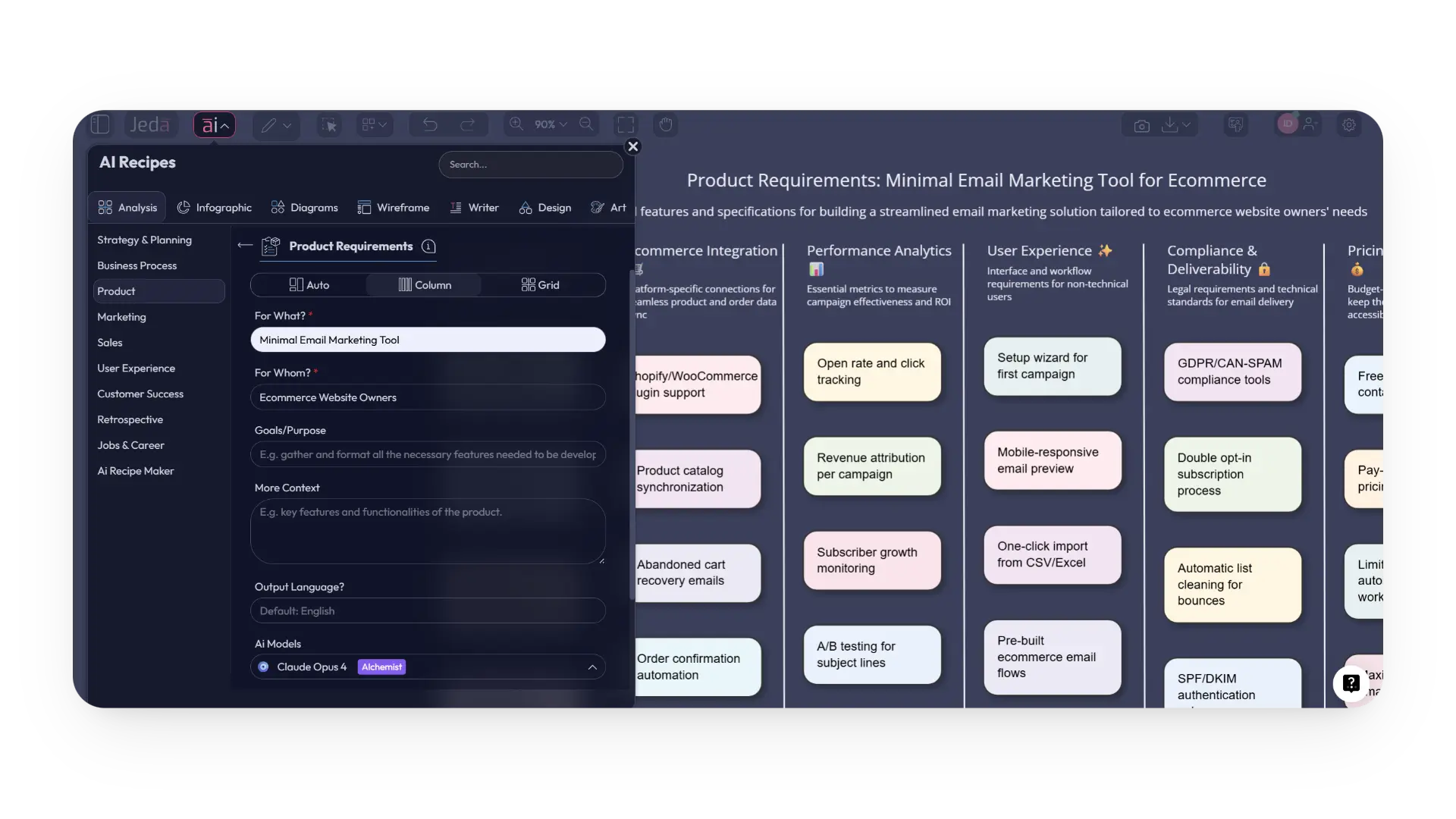
What is a Product Requirements Template?
Product Requirements Template with AI represents the next evolution, but let's start with the foundation. Think of a classic Product Requirements Document (PRD) template as the blueprint for your product, or at least, it’s supposed to be. In an ideal world, this document is the single source of truth that aligns your entire team on the what, why, and for whom of a new feature or product. It’s meant to capture the vision, scope, and key functionalities to guide developers, designers, and stakeholders from concept to launch seamlessly.
The Core Components of a PRD
A solid template structures your chaos. It typically includes sections for clear user stories, detailed acceptance criteria, and well-defined functional requirements. You’ll also find spots for success metrics (KPIs), assumptions, and release timelines. The goal is to answer every possible question before it's asked, creating a shared understanding and preventing costly miscommunication and scope creep down the line. It’s the playbook everyone should be able to refer to.
Why Traditional Templates Fall Short
So why does this crucial document often fail? The problem isn't the idea; it's the execution. Traditional PRDs are often created in a vacuum by a product manager, leading to a lack of buy-in. They become static, text-heavy PDFs or Docs that are difficult to update, so they grow stale. This is the exact pain point that makes teams yearn for a dynamic solution where they can Generate Product Requirements Template with AI.
Why Static Product Requirements Templates Fail
You know the drill. You spend weeks perfecting a massive Product Requirements Document, only to find the engineering team built something completely different. Why does this keep happening?

🎯 The Communication Breakdown
Static documents create instant friction. Imagine handing developers a 50-page PDF filled with text. They’ll inevitably miss key nuances you thought were obvious.
Example: Your PRD says "intuitive user onboarding." But what does "intuitive" mean? Without visual flows, engineers make assumptions, leading to costly rework.
🎯 The Version Control Nightmare
Nothing kills momentum faster than document chaos. You’re dealing with "PRD_final_v2_updated_FINAL.docx" emailed across five departments. Sales has one version, support another, and engineering works from an outdated draft. This isn't a process, it's a recipe for misalignment.
🎯 The Siloed Information Trap
Critical context gets buried. User interview snippets are stuck in Appendix C. Market research is in a separate deck. Your PRD becomes a disconnected document, not a collaborative hub for decision-making.
This chaos is exactly why modern teams are learning to Generate Product Requirements Template with AI that lives and breathes with the project.
Common Mistakes That Derail Product Development
Even with the best intentions, teams often stumble into these common traps that turn product requirements into development nightmares.
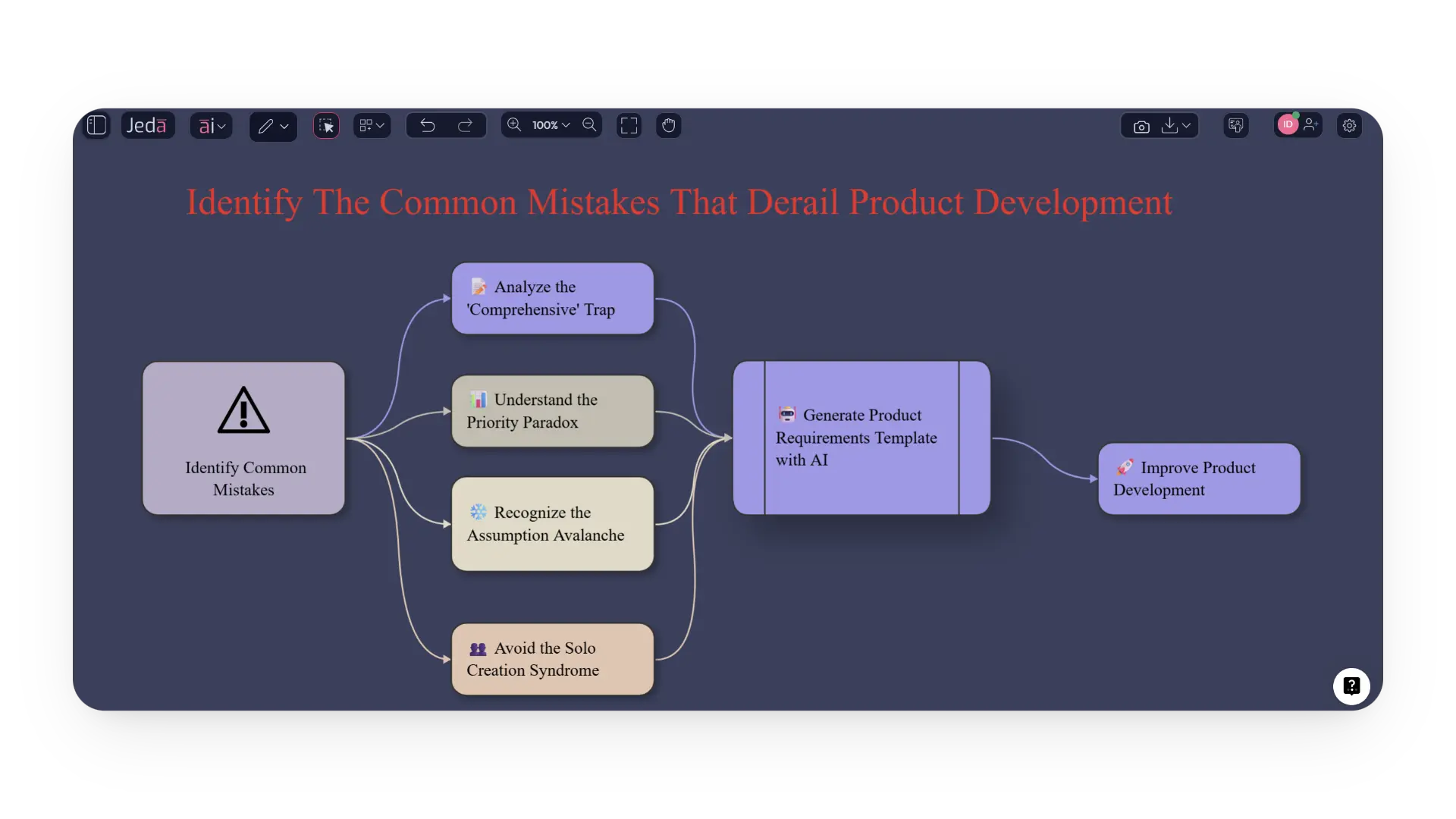
⛔ The "Comprehensive" Trap
Many teams create enormous PRDs trying to cover every possible scenario upfront. This "waterfall in agile clothing" approach backfires Spectacularly! For example, detailing 50 features for a mobile app launch only to discover users only care about three of them. The result? Wasted effort and impossible maintenance.
⛔ The Priority Paradox
When everything is marked "high priority," nothing actually is. Imagine a PRD where social sharing, advanced analytics, and AI recommendations are all labeled "P0." Development teams have no clear starting point, leading to random feature selection and missed deadlines.
⛔ The Assumption Avalanche
Building features based on stakeholder opinions rather than user data is like designing in the dark. Picture a team adding complex customization options because the CEO requested them, while user testing shows 90% of people just want simplicity.
⛔ The Solo Creation Syndrome
When PMs work in isolation, they miss crucial technical and design perspectives. Think of specifying a "seamless payment integration" without consulting engineers about API limitations, or designing a "beautiful dashboard" without involving UX designers.
These fundamental flaws in traditional approaches create the exact pain points that make teams seek better solutions. That's why learning to properly Generate Product Requirements Template with AI becomes so valuable for modern product teams.
The Real Cost of Poor Requirements
The though of a Product Requirements Template with AI begins by understanding what's at stake. Let's talk about the hidden bills coming due from requirement gaps.
The Rework Rabbit Hole
Poor requirements create a vicious cycle. Developers build, then rebuild, then fix what was misunderstood. This isn't just frustrating, it's expensive, consuming resources that could drive real innovation forward.
The Feature Graveyard
Ever launch a product and discover most features go unused? This waste stems from misaligned requirements that missed what users actually needed, building things nobody asked for.
That's why learning to properly Generate Product Requirements Template with AI becomes crucial for escaping these costly patterns.
What Makes a Product Requirements Template Actually Work?
Ever wonder why some product requirements become the team's guiding light while others collect digital dust? The difference lies in moving from static documents to dynamic collaboration hubs.
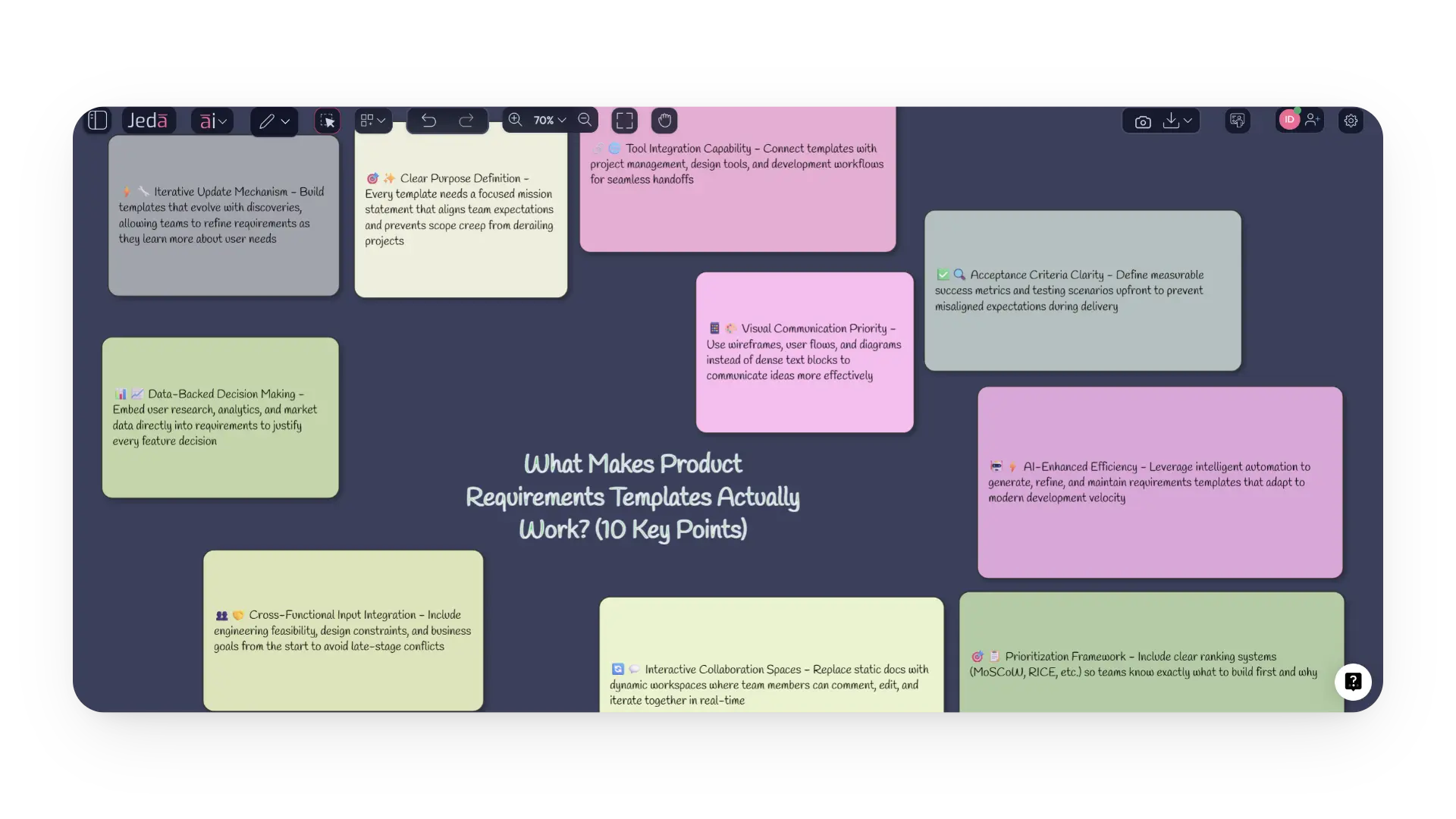
♦️ From Documents to Living Workspaces
Traditional templates create isolated documents, but modern teams need interactive environments. Think of a shared visual canvas where everyone can contribute simultaneously, rather than passing around email attachments that nobody reads.
♦️ Collaboration Beats Solo Creation
The most effective templates emerge from team input, not individual genius. When engineers, designers, and stakeholders co-create requirements, you catch issues early and build shared ownership from day one.
♦️ Visuals Trump Text Walls
Instead of lengthy descriptions, successful teams use flow diagrams and mockups. For example, showing user journey maps alongside requirement specs helps everyone understand the actual customer experience being built.
♦️ Data-Driven Beats Assumption-Led
Modern templates connect directly to user analytics and research. Imagine seeing customer feedback and usage data right beside your feature specifications, making decisions transparent and evidence-based.
♦️ Continuous Updates Beat One-Time Creation
The best templates evolve with Your Product. They're living documents that track decisions, changes, and new insights - never becoming outdated or irrelevant to the current development cycle.
This evolution from static paperwork to dynamic collaboration is exactly why forward-thinking teams are learning to Generate Product Requirements Template with AI solutions that keep pace with modern development needs.
The Visual Requirement Revolution
'Product Requirements Template with AI' thinking begins by recognizing that pictures speak louder than paragraphs. The secret to creating PRDs that teams actually use isn't better writing, it's better visualization that brings requirements to life.
Show, Don't Just Tell
Instead of describing user flows in text, diagram them visually. Create priority matrices that make trade-off decisions obvious to everyone. Integrate wireframes directly alongside functional specs so designers and developers see the same vision.
Build Collaboration Hubs, Not Documents
Transform your template into a dynamic workspace where engineers, designers, and stakeholders co-create in real-time. Enable contextual commenting and maintain version history that shows how decisions evolve through team discussion.
This shift from static documents to interactive visual workspaces is exactly why progressive teams now Generate Product Requirements Template with AI platforms designed for modern collaboration.
Why Your Current Tool Stack is Failing Product Teams
If you're constantly switching between apps just to manage your product requirements, you're not alone; you're experiencing the modern product manager's daily reality.

♠️ The Digital Scavenger Hunt
Imagine this typical workflow:
You're documenting in one platform, checking designs in another, managing tickets in a third tool, while discussions happen across multiple chat channels. This constant context switching creates what feels like a digital scavenger hunt just to find basic information.
♠️ The Hidden Cost of Fragmentation
Every time you copy-paste between a whiteboard and your documentation tool, or recreate diagrams for stakeholder presentations, you're not just wasting time,you're losing crucial context. Important decisions get buried in chat history, design feedback lives in comment threads, and customer insights remain stuck in research platforms.
♠️ The Productivity Paradox
More tools were supposed to make us more efficient, but they've created a new problem: integration overhead.
You spend more time maintaining connections between systems than actually thinking about product strategy. This fragmentation forces teams to choose between comprehensive documentation and actually moving forward with development.
♠️ The Collaboration Breakdown
When your tool stack resembles a patchwork quilt, alignment suffers.
Engineering references outdated specs because the latest version is in a different platform. Stakeholders review mockups without seeing the accompanying user stories.
The left hand literally doesn't know what the right hand is building.
This tool fatigue is exactly why teams are seeking unified solutions that let them Generate Product Requirements Template with AI capabilities within a single, coherent workspace rather than wrestling with disconnected systems.
Generate Product Requirements Template with AI: The New Standard
What if you could skip the blank-page syndrome and start with 80% of your PRD already structured? Welcome to the era where artificial intelligence transforms how product teams approach requirements.
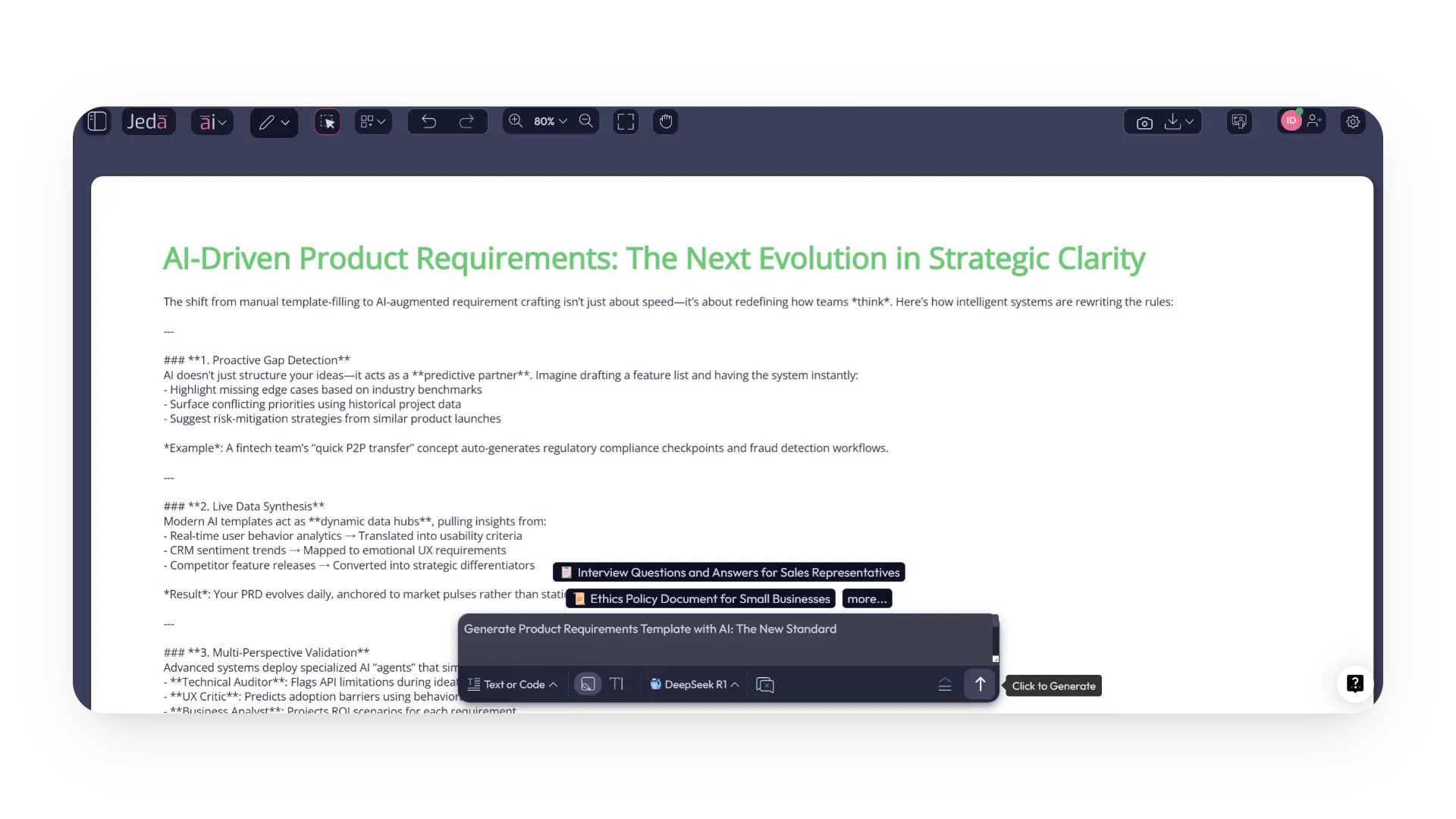
➡️ Accelerate Your Creation Process
Imagine pasting your product brief and watching an intelligent workspace (such as Jeda AI) automatically generate structured user stories. Or uploading customer interview transcripts that instantly transform into validated requirement categories. These AI tools don't just save time, they ensure you never miss crucial elements that traditional templates might overlook.
➡️ Enhance Quality Before Engineering Sees It
The most powerful AI workspaces (like Jeda.ai) act like experienced product consultants reviewing your work. They seamlessly flag potential user experience conflicts before they reach development. They identify requirement gaps by comparing your document against proven patterns from thousands of successful products. Think of it as having a senior product advisor available 24/7.
➡️ From Data to Requirements Instantly
Modern teams feed analytics directly into their requirements process. AI can convert usage patterns into specific acceptance criteria. It transforms support ticket trends into prioritized feature requests. This creates living requirements that evolve with your actual user data rather than remaining static assumptions.
➡️ The Collaborative AI Advantage
The best systems turn requirement creation into a team sport. Multiple AI models work together, one checking technical feasibility while another validates user experience flows. This creates a robust review process that catches issues traditional methods might miss, ensuring your final document is bulletproof before development begins.
This intelligent approach represents the new gold standard for teams ready to Generate 'Product Requirements Template with AI' systems that think alongside them. The future isn't about replacing product managers, it's about amplifying their impact through smart collaboration.
Why THIS AI Workspace (Jeda AI) Transforms Product Requirement Management
Imagine having a product thinking environment that actually thinks with you, not just another tool to manage. That's the fundamental shift happening in requirement management today.
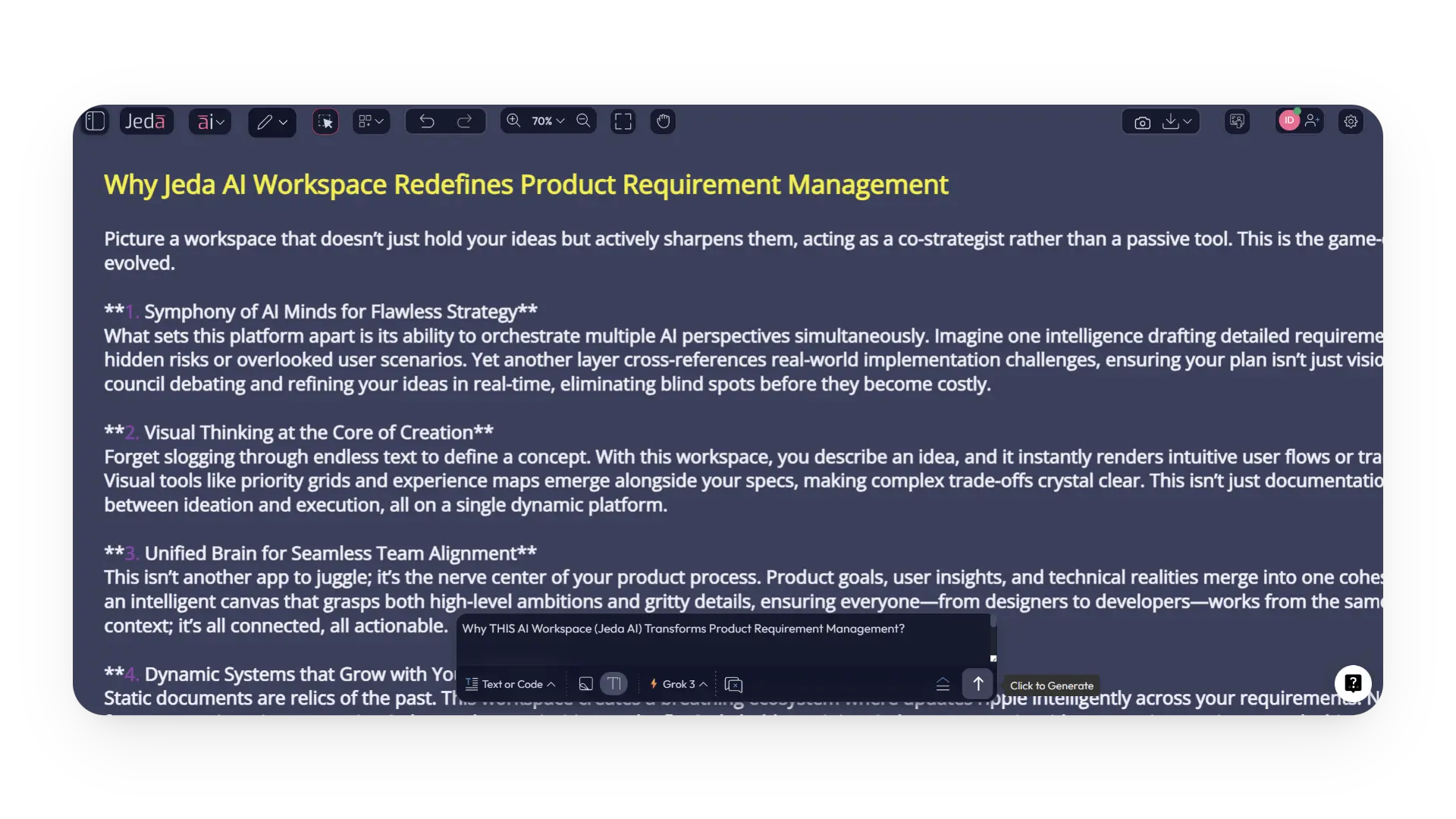
🎉 Multi-AI Reasoning for Bulletproof Planning
The most advanced systems leverage multiple AI models working in concert. Think of it as having an entire product team inside your workspace: one AI generates comprehensive requirements while another plays devil's advocate, identifying edge cases and potential gaps. A third might analyze technical constraints based on similar feature implementations, creating a robust validation system that catches issues any single AI might miss.
🎉 Visual-First Requirement Crafting
Instead of starting with text, imagine describing a feature and watching user flow diagrams automatically generate alongside your written requirements. You can sketch a rough interface concept and see it transformed into clean wireframes. Priority matrices visually illustrate trade-offs, while customer journey maps directly connect pain points to specific solutions - all within the same collaborative canvas.
🎉 The All-in-One Intelligence Hub
This isn't about adding another tab to your already crowded browser.
The most effective systems serve as your central intelligence hub where product briefs, customer feedback, and technical specifications converge. Teams collaborate in real-time on a Visual AI Canvas that understands both the strategic vision and practical execution needs.
🎉 From Static Docs to Living Ecosystems
Traditional requirements become outdated the moment they're saved. Jeda AI Workspace maintains living ecosystems where changed user research documentation updates relevant requirements, where engineering feedback directly influences feature prioritization, and where stakeholder input integrates seamlessly without version chaos.
This represents the evolution from document management to product intelligence, where teams Generate Product Requirements Template with AI - systems that understand context, anticipate challenges, and transform how products come to life. The future belongs to environments that don't just store requirements but actively help teams think through them.
How to Generate Product Requirements Template with AI on Jeda.ai's Visual AI Canvas

Generate Product Requirements Templates with AI Recipes
✨ Log in to Jeda.ai and enter an AI workspace of your choice.
✨ Navigate to the AI Menu located at the top left corner. Under Product, select the option for the Product Requirements.
✨ Respond to a few intuitive questions related to your business or project.
✨ Choose your preferred layout and AI model(s).
✨ You may upload and select your project/product specific data or doc files.
✨ Hit “Generate”.
Generate Product Requirements Template with AI Prompt Bar using Jeda.ai’s Agentic AI Workspace
⭐ Enter your desired Jeda.ai Workspace.
⭐ Towards the bottom of your Workspace, you'll see the AI Prompt Bar. Click on it and select the "Analysis" command. Then type in your required query about the Product Requirements template.
⭐ You may fine tune your brainstorming process with a wealth of prepopulated dynamic prompts provided by the AI.
⭐ When you're satisfied with your prompts and parameters, all you have to do is choose a preferred layout, select one or more AI models and hit the "Generate" button.
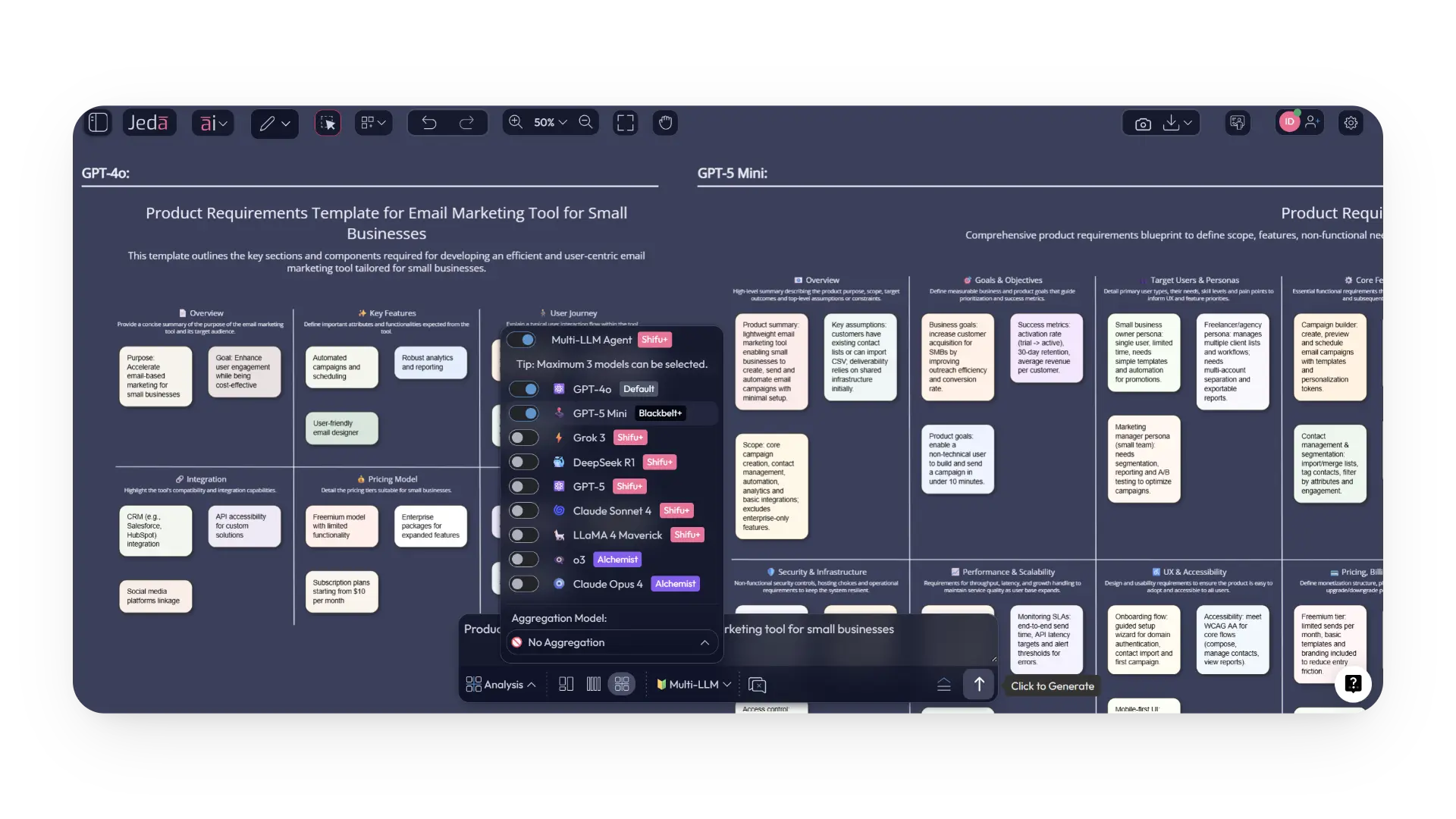
Beyond the Template: AI-Powered Product Discovery
The thought of Product Requirements Template with AI extends far beyond document or template creation, it transforms how you discover what to build. Modern teams use intelligent workspaces as their discovery engine, turning scattered insights into actionable strategy.
Customer Intelligence at Scale
Imagine uploading customer interviews and watching Jeda AI identify recurring pain points across hundreds of conversations. Support tickets cluster into feature categories, while competitor analysis reveals gaps in your market positioning. This turns qualitative data into quantitative direction.
Visual Prioritization That Makes Sense
The most advanced systems let you model different scenarios visually, weighing impact against effort with AI-suggested weights. You can simulate outcomes before committing resources, creating alignment across your entire organization through clear, visual roadmaps.
This holistic approach ensures you're solving real problems, which is why forward-thinking teams now Generate Product Requirements Template with AI platforms that connect discovery to delivery seamlessly. E.g., Jeda.ai's Agentic AI Canvas.
Real Teams, Real Results
Product Requirements Template with AI adoption shows remarkable productivity gains across organizations. Teams consistently report transformative outcomes when integrating intelligent systems into their workflow.
Velocity Transformation
Product development cycles accelerate dramatically with AI-assisted requirements. Teams ship features weeks earlier by eliminating documentation bottlenecks and rework delays that traditionally slow progress.
Quality Revolution
Engineering satisfaction soars when requirements contain fewer ambiguities and gaps. Clear, AI-validated specifications reduce frustrating back-and-forth, letting developers focus on building rather than clarifying.
Alignment Breakthrough
Stakeholders report better strategic alignment when visual AI workspaces, like Jeda.ai, make complex trade-offs understandable to everyone. Cross-functional teams finally speak the same language throughout the development process.
These measurable improvements explain why progressive organizations now Generate Product Requirements Template with AI solutions as their standard practice.
Wrapping Up
Product Requirements Template with AI represents the perfect partnership between human creativity and machine intelligence. The best product thinkers aren't being replaced, they're being amplified, freed from administrative tasks to focus on solving real customer problems.
Your requirements should work as hard as you do. Imagine a living strategic asset that evolves with your learning, aligns your team effortlessly, and turns insights into action without the manual busywork that drains creative energy.
This isn't about another tool, it's about a fundamental shift in how products get built. When AI handles the heavy lifting, teams can focus on what truly matters: understanding users, testing bold ideas, and delivering exceptional value faster than ever.
The transformation begins when you Generate Product Requirements Template with AI, a system designed for thinkers, not just document managers.




%202.svg)